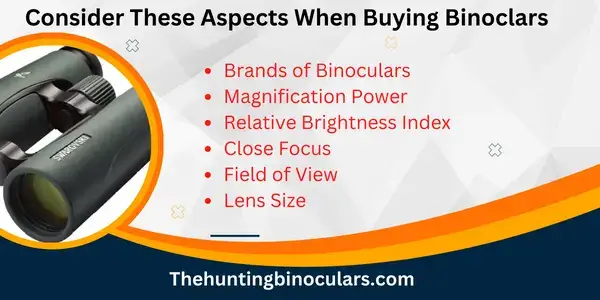
Binoculars are helpful to use for hunting, birding, stargazing, hiking, and sporting events. You must be aware that there are multiple types and brands of binoculars that are manufactured for different purposes. But the question is how binoculars are rated. So, it is based on multiple factors that are essential to take into account.
Well, you must be prepared for compromises while selecting the best binoculars for wildlife or bird watching. For this, priorities must be specified, and less important elements must be evaluated. You must understand the binocular ratings and requirements. Also, you should be aware of how much you are going to spend on binoculars.
How you can rate the different types of binoculars and what do you need to consider? Let’s start a brief discussion on it.
Table of Contents
How Binoculars are Rated? What Points Consider Before Buying Binoculars
When it comes to understanding binocular ratings, there are different aspects to consider that I am going to discuss below:
1. Brands of Binoculars
Numerous well-known binocular brands are available in the market that you can choose from. They include Swarovski, Leica, Zeiss, Celestron, Nokia, Vortex, Nikon, Wingspan, and others. Also, numerous varieties are available that range in price from inexpensive to costly, with different types of lens coatings, and optical glass. It also includes ergonomic features that make the binoculars compact, portable, and generally effective.
You must be prepared to spend from $2000 to $3000 if you decide to select one of these manufacturers’ premium models. When there are different versions available for much less money, many people ask why binoculars need to be so pricey.
Thus, if you have used such high-end binoculars for some time and have experienced this extraordinary visual ease and pleasure, you will understand the price difference.
2. Magnification Power
Binoculars are classified by magnification, or how much a binocular enhances an item. For instance, if a pair of binoculars has an 8X magnification, it will make distant objects 8 times wider than they would appear to the unaided eye.
This is the reason; the binoculars’ magnification is one important feature. The binoculars with 10x magnification and those with 8x magnification are the most famous. The most appropriate magnification also relies on your unique needs.
For instance, 10x is a better magnification if you intend to make long-distance views and see objects on a deeper level.
3. Relative Brightness Index
According to the principle, the relative brightness index describes how bright an item should be when seen via a pair of binoculars. The escape/exit pupil is divided to obtain this index. For instance, if a binocular’s exit pupil is 6.25, its relative index will be 37.5. This amount was calculated by dividing 6.25 by 6.25.
In this way, the brightness index is also an important factor to take into account while considering the binocular ratings.
4. Close Focus
Close-range focus is indicated by the term “close focus.” The closest item to the binoculars that can still be concentrated is at that range. This is another crucial characteristic to take into account if you would like to see insects or other interesting things close by.
The near-focus area of really effective bird-watching binoculars is as low as about 6 feet, but there is a cost involved. With more magnification, the shortest path for close focus gets longer.
5. Field of View
The diameter of the circular region you can see via a pair of binoculars is referred to as the field of vision. At a range of 1000 yards, this distance can be calculated in feet. In short, the field of view is the region you can see through a pair of binoculars.
6. Lens Size
The Aperture, or the diameter of the objective lens, is another essential aspect to think about when buying binoculars. For a clearer vision, the diameter should be 5 times the magnification.
For bird-watching binoculars, the measurement of the glass size is an important component. The specifications for the front lens are on the distant end, and it is stated in millimeters of the objective lens. Thus, the lens sizes of a normal 7x size, 35s binocular are 35mm, 842mm, and 42mm, respectively.

Types of Binoculars
The following list of binocular types can be used to distinguish between several kinds of binoculars:
Roof Prism Binoculars
Roof prism binoculars are among the most recent binoculars of all. Compared to the more traditional Porro prism binoculars, they are more efficient, straight-tubed, ultralight, and portable. They appear to be a more streamlined version of conventional binoculars.
Porro Prism Binoculars
Porro prism binoculars are the next common type of binoculars. These binoculars are the original model. The Porro prism idea works by horizontally sweeping the light from your focal length through a set of linked triangle light-catchers. The light is then amplified and inverted by this motion. This will provide you with a clear and enlarged view of your object.
Night Vision Binoculars
Binoculars and other night vision equipment are electrically enhanced optics that use several photon-enhancing modules. They help to increase the limited amount of available lighting. Your eyes will be given useful views after this procedure to assist you in exploring the dark.
Marine Binoculars
A particular form of binoculars made for use in and around water is called a marine binocular. They have a low to medium magnification power and a broader ocular and object lens. You will need something that has a bigger view field with a lower magnification when on the open seas. So, this binocular will be the best option.
Astronomy Binoculars
You will undoubtedly need a set of binoculars that are made especially for observing the stars if you are a passionate astronomer or stargazer. A telescope is excellent, but there are instances when neither one is available nor practical. So, an astronomy binocular is the finest choice for this.
Opera Binoculars
These are utilized to see opera, musicals, and theatrical productions. It might be challenging to fully comprehend the complex work that musicians and performers take into their art. But these specially made binoculars will enable you to see even the smallest motions.
How are Binoculars Rated for Power
You must be familiar with the size of the lens aperture and magnification power commonly used to rate binoculars. When you have a set of binoculars, the first figure you will find is the magnification power, such as 8×42 or 10×50.
This figure represents how much wider the object will look when viewed through binoculars than it would be with the unaided eye. So, an image will look eight times nearer with a set of 8×42 binoculars than it would look without them.
In a binocular classification, the objective lens size is indicated by the second number, such as 8×42 or 10×50. This figure represents the front lens’s size in millimeters. In low-light conditions, a bigger field of view will enable lighters to reach the binoculars. So, it also increases the size and weight of the binoculars to give you clarity.
Furthermore, you must take into account your desired use when selecting a set of binoculars. Also, you must choose a balance between the amplification strength and the effective focal length that suits you.
For instance, let’s say your primary intention for utilizing your binoculars during the day is to observe birds. You might use a lesser magnification power, such as 8x or 10x, to avoid having heavy equipment.
Also, choosing a higher resolution power, such as 12x or 16x, can allow you to view faraway objects with greater clarity if you enjoy stargazing.
FAQ’s
-
How To Choose Binoculars For Hunting?
One of the most important factors to think about when searching for a set of binoculars for hunting is magnification. A binocular with a magnification of 7 to 10X will work perfectly for hunting. Anything greater than 10X will be challenging to stabilize when out in the bush.
-
What is Eye Relief in Binoculars?
The space between your eyes and a binocular lens is known as eye relief. This range is expressed in feet. An extended eye rest relieves tension, particularly for those who wear eyeglasses.
-
Are Safety and Ergonomic Essential Factors to Consider For a Pair of Binoculars?
Good binoculars from well-known companies incorporate ergonomic elements into their structure to encourage convenient usage. So, you must make sure the type you choose is modest and check it out in your hands to determine whether it is comfortable and lightweight.
Conclusion
By considering all the factors that I have explained in this article, you can understand how binoculars are rated. Also, you must be aware of all the different brands and types of binoculars to fulfill your requirements by buying your preferred item. For this, you must specify your requirements and then decide to buy one according to that.
How was your experience with this article?
Read!
